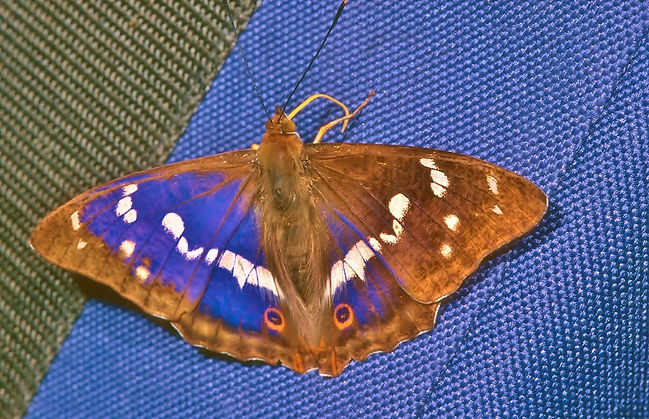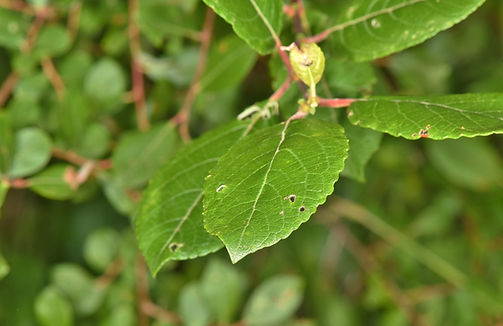
Ashley Whitlock
Hampshire & IOW Butterflies and Moths
If you go down to the woods today.......

Most people want to see the Purple Emperor on the ground. This is a typical pose of the species with its wings open and ibibing on stony ground getting nutrients up its proboscis . Most of the time you very rarely see the Purple Sheen on both wings, its either the left or the right. You have to be standing right over the butterfly and normally its better on overcast days.

When out looking in the woods look for bleeding oaks with a substantial sap run, which have been struck by lightning or have been attacked by other forces like the wind or just rotten by age. Here the smell can be quite potent and the Purple Emperor will likely seek this out and imbibe on the sap for many minutes. Some sap runs can be away from you eyesight, and the purple Emperor can be seen sometimes flying well into the bough of the tree, and disappearing for minutes at a time.
Victorians used to drill large holes in the bark of the tree to encourage sap runs and hence get their prize the Purple Emperor, this used to take place in the New Forest and Alice Holt Forest to name a few.

Dog walkers to me should always clean up after their dog has done its business, but on the odd occasion during the summer they can be quite forgiven when they leave a deposit on the ground which invariably will attract the butterflies like Commas Red Admirals, but none more so than his Imperial majesty, which will sit on the dog poo for many minutes giving you a good viewing of this gracious insect.

Over the years I have managed to attract the Purple Emperor on to my camera bag, where it has stayed enjoying whatever it can find for up to an hour or so. Maybe its transfixed by the colour which it is very similar to its wings?

A typical ride in a Purple Emperor wood with wide vistas looking towards the crowns of the Oaks. This is the kind of vista to look for when the Emperor is Oak edging and Sallow searching in the morning.

Another typical woodland ride where you would encounter the Purple Emperor, this is Whiteley Pastures and Botley Wood near Fareham in Hampshire.

The mornings should be spent looking up at the Oak crowns to see the male Purple Emperor flying in and out of the sprigs of leaves and over the tops of the crowns going one way down a ride then back down the other side, looking for potential females. Later on they will start to hunt in and around good Sallow stands, and then around about mid-day towards one o'clock in the afternoon they will have made there way up to a Assembly point to fend off other males in the areas, establish a territory and flex their muscles, hoping a potential female has been looking on, and courtship may start .

A typical ride in a Hampshire wood, this is Havant Thicket, and this ride is over a mile long, and several males in a good year could be encountered along a ride like this following the contours of the Oak stands.
.jpg)

The Pussy Willow, Sallow 'Caprea' is the main food plant of the Purple Emperor caterpillar in woodland and along hedgerows, river and wet meadows. Matthew Oates has calculated that a good Purple Emperor wood needs at least 400 of these trees of different ages,and particularly the female variety which have the furry underside, just one of the needs to hold a good population of the Purple Emperor. In my experience walking around a lot of woods in Hampshire there is nowhere near that number. Although the Female Purple Emperor will lay on the narrower leafed Sallow, and other hybrids in its effort to lay her eggs.
Just like my 'other' species the Duke of Burgundy the Purple Emperor is not renown for feeding off of flowers, but occasionally they will buck that trend. I have seen amale on Bramble before in Goose Green Inclosure. Females are often seen on Buddleia, this may well be that it's another source of vitamins for the egg-laying process.

The future of wildlife and especially rarer flora and fauna can be seen at the fantastic Knepp Wildlands in West Sussex,I know its not Hampshire, but I think in the next 10-20 years we will have sites like this in practically every county. Knepp has the possibly the largest population of Purple Emperors anywhere in the world, which is a pretty bold statement. (Photo Knepp estate)
How to find Dangle Leaf on Sallow
by Matthew Oates
The 2025 Dangle Leaf Season will shortly start! We used to dread November: not anymore! Bring it on! After the flight season, it's the best time of the Emperoring year.
'Dangle Leaf' is by far the easiest way of finding any of the immature stages of the Purple Emperor. Indeed, it is often easier than detecting the territorial males.
Text first, then piccies.
1 During the autumn, PE larvae strengthen the petiole join of their seat leaf and feeding leaves with copious amounts of silk (after the 1st instar, PE larvae are serial spinners of silk).
2 Larvae then vacate the browning leaves and wander off into hibernation (the odd one tries to hibernate on the leaf).
3 The petiole join then breaks, but the silk prevents the leaf from falling to the ground.
4 Instead, vacated seat leaves and feeding leaves stay attached to the twig stem for an indeterminate period - depending on windiness, rainfall and the amount of silk.
5 Most 'dangles' last for about a week, but in well-sheltered situations (e.g. stream gullies, sallow along thicket-stage conifer plantations) they can persist for a few weeks. One gale, let alone a named storm, and most blow off. Very few survive till Christmas.
6 However, there are 'early', 'mainstream' and 'late' leaf-fall sallow - the latter often staying green into December. Much depends upon the arrival of frost, and the intensity of the summer or autumn (traditionally, in the Purple Empire, the first frost used to occur around Bonfire Night).
7 The 'early' leaf-fall sallow will be ready for Dangle Leafing very soon.
8 This year, the main Dangle Leaf period is likely to start in mid-November and end in early December - but much depends on the weather.
9 The 2025 Dangle Leaf season could be MEGA, because larvae are present in unusually high numbers this autumn (despite high mortality rates amongst young larvae in the July and August heatwaves).
10 To practise Dangle Leaf, you'll need a hooked stick (ideally a shepherd's crook) and a pair of binoculars, and patience. Those who spent their youth fishing are well placed to go Dangling.
11 In good light, wander the woods, inspecting sallow which have dropped 50% to 75% of their leaves, looking for bronzed or (usually) deep-brown leaves spinning gently in the breeze. On still days, give the sallow a tap, and watch for spinning leaves. Windy days are difficult, with too much leaf movement.
12 Usually, you'll need 2-3 minutes per tree. This means that Dangle Leafing enables you to cover a lot of ground.
13 But, beware of false prophets: leaves spinning on a thread of brown broken stem, leaves attached by spider silk (rare this autumn) or tangled with white feathers.
14 A true Dangle Leaf is diagnostic of Apatura iris. No other UK Lepidopteron does this. An experienced Dangler can tick off a new location by merely spotting a good dangle, without finding the larva.
15 However, the hibernating larva can usually be found within 2m of a Dangle Leaf cluster. Most are aligned alongside middle-sized buds, or in forks. Occasionally, they hunker down in a bark scar. They very rarely venture into fissured bark. Seemingly, many get predated whilst crawling about prior to conking out, so don't worry too much if you can't find the 'pillar (look again in spring).
16 Ideally, repeat visits over a 2–3-week period, to locate early and late larvae and dangles.
17 Tell nosy parkers you're looking for biodiversity (they'll leave fast).
18 Forget sallow taxonomy, the Empress speaks a different language to our botanists. Sallows which offers(ed) mid-green foliage are favoured. This autumn, most larvae are on sallow with a shaded south-facing aspect (tall trees to the immediate south).
19 Most larvae and dangles are annoyingly just out of reach! Hence the need for binoculars.
20 Warning. This is addictive.


